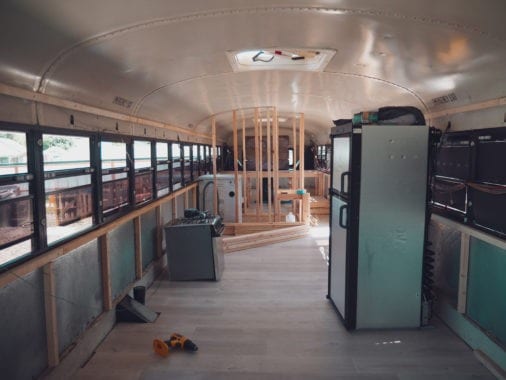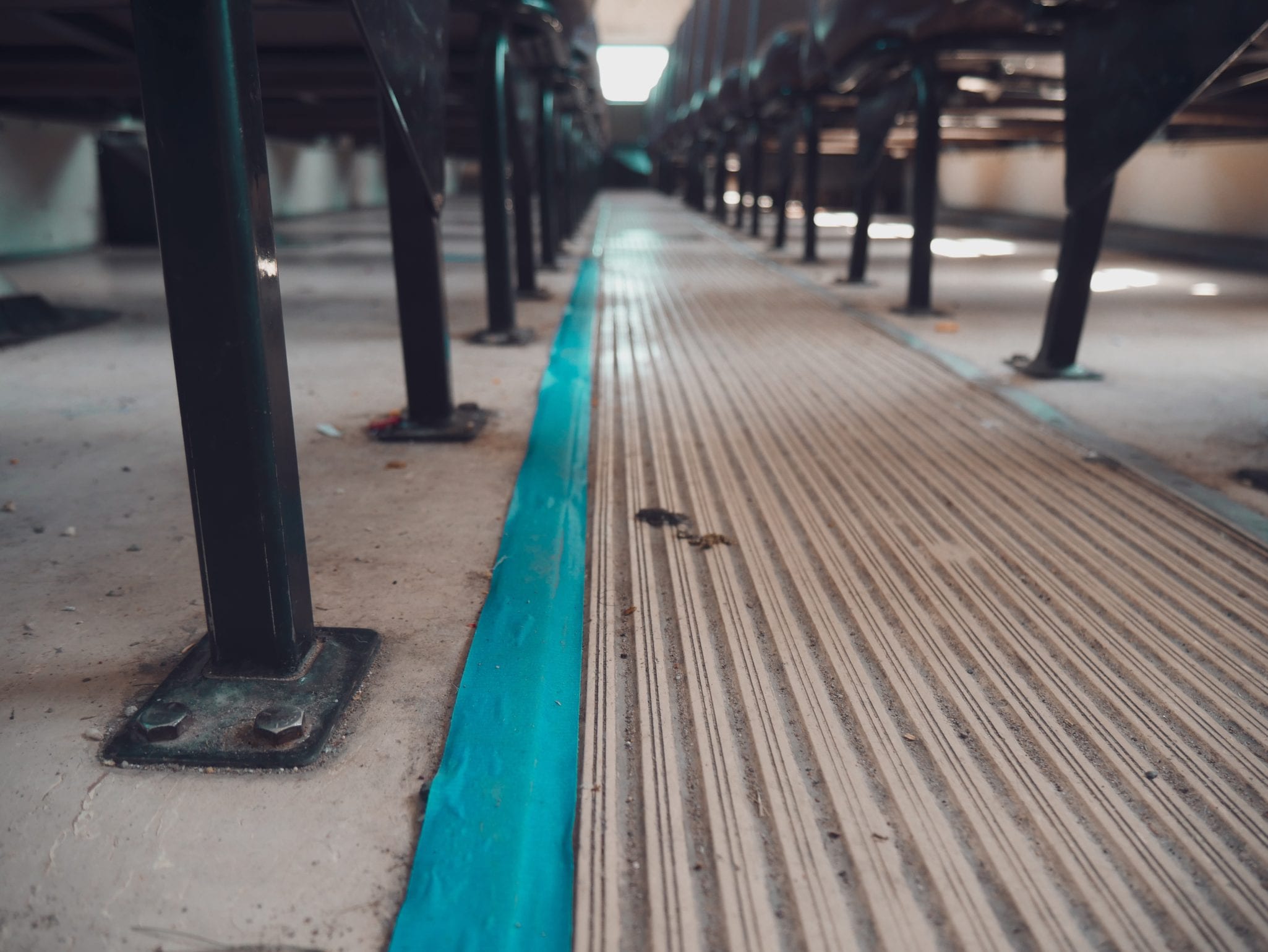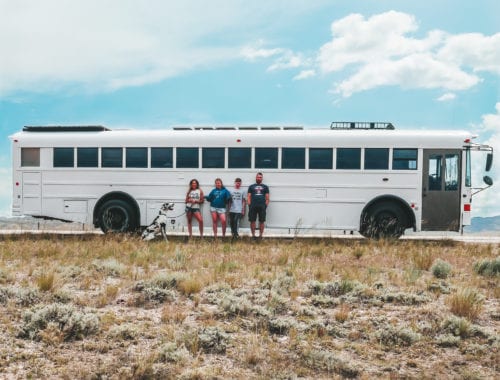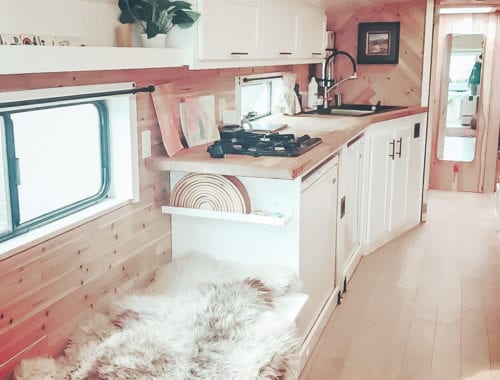Converting a School Bus: Things to Consider
Converting a school bus can be a really enjoyable experience, but it isn’t easy. Between finding the right bus, tearing it all apart, building your home inside, and making sure you have enough cleverly-designed storage, it can become quite a long and arduous project.
The number one thing is determining what you want to use your bus for. Why are you choosing to live in a skoolie?
Do you plan to travel and see the world, or just be stationary and connected to shore power and water all the time? Will you be living in your skoolie full-time, or part-timing it? How many people need to have space on the bus?
Having all of your expectations and needs laid out before you buy a bus can help you avoid potential issues and save both time and money.

However, there are a myriad of other things to be aware of if this is the journey you plan to embark on.
This article is a compilation of all the details and surprises we were confronted with (and hadn’t necessarily planned for) on our journey. Hopefully, if not just to entertain, it will help save you some trouble along the way.
LEGALITIES
Laws will vary slightly from state to state, but here are the relative generics you’ll find regarding school bus ownership.
REGISTRATION
Before you can get insurance or legally drive your bus without a CDL (commercial driver’s license), you have to register it as an RV.
In order for us to do that, we had to have a local officer come by and verify all flashing lights and the stop sign were disabled/removed, permanent plumbing was installed, seats were removed, and a designated area for sleeping.
It is illegal to leave “School Bus” printed anywhere on the bus, as it could be misleading and potentially dangerous for children.
Before converting a school bus, look up the laws in your state to see exactly what you need. Generally, if you are going to live in your bus, you will have naturally fulfilled all these requirements once it’s completed. Otherwise, drive the bus at your own risk, as you will be fully liable for any accidents that may occur.
INSURANCE
Speaking of insurance, we found insurance companies to be pretty hit-and-miss when it comes to insuring skoolies. Generally, a skoolie is insured as an RV.
And don’t be surprised if they only offer you liability insurance instead of full comprehensive.
Most likely, you will also have to provide photos to your insurance company as proof of your conversion. These photos should encompass the same checklist that was needed to register your bus.
LICENSING AND DRIVING
We get asked all the time if a CDL is required to drive our 40′ long home. The answer is no – a CDL is not required.
It is registered and treated like an RV.
Frighteningly, anyone with a regular license and no experience whatsoever handling large vehicles can get into a 25-ton, 50-foot motorhome and take it 80mph down the freeway.
Convenient for new skoolie owners? Yes. Common? Yup. Legal? You betcha. Is it horrifying knowing all those huge RVs on the interstate require no extra training? Incredibly.
Find an empty lot and practice driving before converting a school bus and filling it with valuable things. Get intimate with your bus before taking any road trips, especially to areas you’re unfamiliar with.
Learn its pivot points for left and right turns (usually near the rear wheels). Lefts are easy. Rights, require extra space and practice.
Identify where you need to be in the lane, as you’re quite a bit wider than a normal car. It will feel different. Learn how to use your mirrors. We also recommend installing side and rear cameras. Can you back it up? Park? Turn around in a tight space if necessary?
Oh, and it will be necessary. At one point or another, you will be that guy or gal. You also need to know exactly how tall your bus is. This includes extra racks, solar panels, and anything else you’ve added to the roof. You don’t want to find out a detail like that when going under a bridge for the first time.
SPACE
Although seemingly obvious, this one is often under-prioritized.

Clearly, if you are moving your whole life into a bus, you will need to do some significant downsizing. More than you think.
Even so, when you design each piece of furniture and every space of the house, you should be thinking of “storage.” Everything in your bus will need its own specific and dedicated space.
WATER TANKS
One thing that often gets forgotten in initial planning is your tanks.
You should have space for your multiple water tanks and propane tanks. If you’re lucky, you’ll have a big storage compartment under the bus that seems to be made for that stuff. Otherwise, you will have to make special additions to strap it up underneath.
Are you going to have a regular water heater and the tank to go with it? If so, where will you put it?
Or will you choose an on-demand (tankless) water heater? The bonus of an on-demand water heater is that it saves a ton of space and your water doesn’t go cold mid-shower, and that’s what we ultimately chose for our needs.
This Tankless LPG water heater, as a matter of fact, is sleek, affordable, and just what we needed to save space and make sure all four people living in our bus could get a shower.
OCCUPANTS
Something else to think about when converting a school bus is how many people/animals will be on the bus with you. If you have a dog, where will it sleep? If you have kids, have you made enough room and storage for them? Will they feel like they have their own personal space?
Knowing that we would be living full time with two teenagers that homeschool made us opt for a more closed-off plan than we would have had it just been us so that everyone had their own respective privacy and space.
We also made our bedroom bigger, since we would be sharing it with our huge Great Dane, Apollo.
UTILITIES AND APPLIANCES
When deciding what utilities and appliances you need, contemplate the kind of lifestyle you want.
You’re living on a bus, so no matter what you’re going to have to make some sacrifices somewhere, but with some forethought and careful planning, you can make it comfortable and effective for your needs.

WATER
Water is the first thing to consider. If you plan to live off-grid for long periods at a time that will have a huge effect on how big your water supply will need to be.
Since it’s the first thing to deplete, it might be a good idea to have a pump and filter system so you can pull water right out of a stream or river.
Besides the Flojet Water Pump that is part of our regular plumbing, we also installed a Portable Transfer Water Pump
to fill our tank when we’re out and unable to hook up to shore water. It means we can stay off-grid longer without worrying about running out of water.
You’ll also have to decide whether you’ll only have one tank for both drinking and showering, separate tanks, or if you’ll carry drinking water separately from the tanks.
Ultimately, that’s what we decided, and designed a storage cupboard in the kitchen for our 5-gallon drinking water tank, with this neat little pump.
ENERGY
Most people who opt for skoolie life also install solar power if they’ll be living in their bus for any length of time.
You want to be able to sufficiently power your bus, and any of the extras you decide to use (washing machine, computer, television, etc.), so take the time to measure your energy consumption so you can appropriately size your system.
When converting a school bus, consider the size of your panels and battery bank, the climate (usable sun hours versus unusable sun hours), how much energy you use, and what type of day it is (cloudy or sunny). These things determine how much energy your system generates.
We wanted to make sure we never had to hook up to shore power if we didn’t want to, so we over-killed on our system a little.
That’s another post entirely, but there are pretty cool options like this 800 Watt Solar Panel Kit that include everything you’d need to put together your system, and include options from 200 watts all the way up to 800!
PLUMBING/TOILET
Another decision to make involves your toilet and overall plumbing set-up.
Your two main options for a toilet involve a traditional RV system that needs a back tank and pumping capability, or a composting toilet. There are pros and cons to each.
A traditional toilet will use water from your already limited supply. Composting toilets don’t use any.
Traditional toilets drain into the black tank, so you only have to empty waste periodically at a pumping station.
This is a blessing in day-to-day living but means you have to make space for the black tank, carry the extra supplies to pump it and find pumping stations to legally empty it.
COMPOSTING TOILETS
A composting toilet requires regular maintenance. The solids bin uses a composting agent, like peat moss. This accelerates the process of decomposition of feces, which consists of about 90% water. In time, it degrades everything in the bin to a smaller amount of solid material. From here, it’s safe to handle and dispose of. How frequently you need to empty your solids bin depends on the number of people using it. Empty a composting toilet used by two people every three weeks, as a general rule.
Urine, however, collects in a separate tank and fills up every day or two. Again, this depends on how many people use it.
Both the solid and non-solid waste tanks disconnect from the toilet, which makes emptying them much easier. The upside to using a composting toilet is that you will have no need for a black tank. The downside is that you’ll be a little more up-close and personal with your waste.
We decided on the Nature’s Head Composting Toilet because it meant not having to carry a black tank or deal with the emptying. We decided that though more frequent, we’d prefer to be able to empty it wherever we happened to be instead of finding a station.
APPLIANCES AND FIXTURES
You can save yourself a little on energy consumption if you plan ahead. We found LED Edison bulbs that pull practically nothing from the system and energy star electronics like this TV
.
Our refrigerator can run on gas or electric, meaning it switches to electric mode when the bus is on and gas when it isn’t.
Our range is also propane, and instead of putting in an electric or propane heating system, we put in a real wood stove.

Non-essential appliances, like small kitchen gadgets, TVs, video game systems, computers, chargers, and a washing machine, are all a drain on your power system. Make sure you know what your system can handle before loading your bus with a ton of electronics.
Anything that produces heat electronically (microwave, coffee maker, etc.) uses a colossal amount of energy. Game systems also pull a lot of power. These are things to consider when buying the “fun” stuff for your bus.
We chose to put in a larger system than we calculated, simply to have the extra energy if we added things down the road.
CONVERTING A SCHOOL BUS
This is by no means an all-encompassing list. It is, however, a good place to start.
You may wonder how in the heck you’re going to be able to get all of it sorted out. We were there too. It seemed insurmountable.
But looking back, it all seemed to just fall into place once we got the ball rolling. While starting a bus conversion, reflect on why you are doing it.
If it’s to travel the world, make it to travel the world. If it’s to sit plugged into power and water, make it as cozy as possible.
When converting a school bus, there is no one way to do things. After all, it’s your home! Building a skoolie is an expression of self, and as such, it should reflect you in every way possible.





